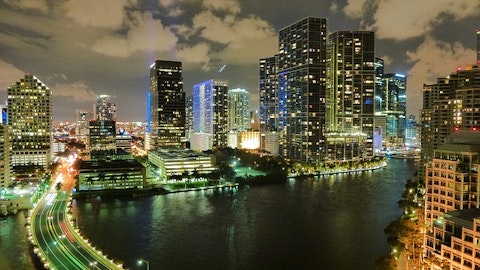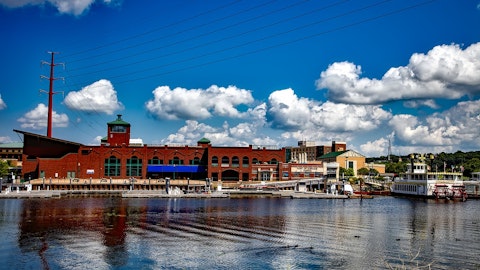In this article, we will take a look at the 15 biggest bilingual cities in the US. If you would like to skip our discussion on the global landscape of bilingualism, you can go to the 5 Biggest Bilingual Cities in the US.
Almost half of the world population is bilingual, with 43% of the people speaking two or more languages, according to the Journal of Neurolinguistics. In the United States alone, there are roughly 67.3 million bilingual individuals, making up 20.6% of the total American population, according to the Centre for Immigration Studies. Bilingualism not only enriches cultures but also provides cognitive advantages and increases global interconnectedness. In today’s interconnected world, bilingualism is increasingly important as it creates opportunities for economic engagement. According to some reports, bilingual employees potentially earn 5-20% more per hour compared to their monolingual counterparts. The benefits of bilingualism extend beyond economic advantages. Being bilingual can also help improve memory, attention span, and creativity. Bilingual speakers are also good listeners as they possess an understanding of various sounds and relevant aspects of speech.
The percentage of people who speak two or more languages varies worldwide. In Switzerland, 42% of people use two or more languages in everyday life, while only 20% do the same in France. The United States also has regions where residents are more likely to be bilingual. El Monte, California, is one of the most bilingual cities in the US, with 84.5% of its population speaking a language other than English. Meanwhile, California is among the most bilingual states in the US, with 46% of Californians speaking more than one language. This is why it comes as no surprise that California has the highest number of online searches related to learning a new language compared to any other state in the US. The top three most multilingual cities in the US are all situated in California as well.
It is interesting to note that Spanish is the most popular second language spoken in the US, after English. There are around 57 million Spanish speakers in the United States as of 2023, which makes the US the biggest Spanish-speaking country after Mexico. Besides Spanish, Mandarin, Tagalog, and Vietnamese are among the top 5 languages spoken in the US. Other popular languages also include French, Arabic, Korean, and German. According to Preply, an online language learning marketplace, Americans are most interested in learning Japanese, Korean, and French, after Spanish and English, based on their search history data. These preferences may stem from individuals’ perceptions regarding the prominence of certain languages in the future. You can find out more about the 30 Most Spoken Languages in the World in 2050 here.
Importance of Bilingualism in the Workforce
The US government has launched several initiatives and programs to promote bilingual and multilingual learning in the US. One such program is the “Being Bilingual is a Superpower” initiative that promotes multilingual education and a multilingual workforce for the betterment of society. Additionally, reports indicate that nine out of ten US employers rely on bilingual staff, with a projected increase in demand for bilingual employees in the future. Many public companies in the US prioritize the recruitment of bilingual resources for their operations, with notable examples including Kelly Services (NASDAQ:KELYA), Danone (EPA:BN), and HubSpot, Inc. (NYSE:HUBS).
Kelly Services, Inc. (NASDAQ:KELYA) is a workforce solutions company that offers a range of employment services, including bilingual job opportunities. Meanwhile, Danone (EPA:BN) is a multinational food company that places a strong emphasis on diversity and inclusion. It actively promotes a bilingual workforce within its organization as part of its commitment to support a diverse workplace. Similarly, HubSpot Inc. (NYSE:HUBS), a leading provider of inbound marketing, sales, and service software, recognizes the benefits of a bilingual workforce and encourages the recruitment of multilingual talent. HubSpot Inc. (NYSE:HUBS) shared an update on the financial performance of the company in its Q4 2023 earnings call:
We saw a solid finish to a good year despite the challenging macro environment. Q4 revenue grew 21% year-over-year in constant currency and full year 2023 revenue grew 25% in constant currency. We delivered a standout operating profit margin of 17% in Q4 and 15% for the full year, up over 500 basis points year-over-year. Total customers grew 23% to over 205,000 customers globally, driven by nearly 11,000 net customer additions in the quarter, a new record for us.
With this context in mind, let’s take a look at some of the most linguistically diverse cities in the United States.

Our Methodology
To shortlist the biggest bilingual cities in the US, we referred to the latest data available from the United States Census Bureau. Our methodology involved gathering information on the total number of people aged five and above who speak a non-English language at home across the country. From the shortlisted database, we focused solely on the largest cities based on the latest population statistics. The biggest bilingual cities in the US have been ranked in ascending order of the percentage of bilingual population.
By the way, Insider Monkey is an investing website that tracks the movements of corporate insiders and hedge funds. By using a consensus approach, we identify the best stock picks of more than 900 hedge funds investing in US stocks. The top 10 consensus stock picks of hedge funds outperformed the S&P 500 Index by more than 140 percentage points over the last 10 years (see the details here). Whether you are a beginner investor or a professional one looking for the best stocks to buy, you can benefit from the wisdom of hedge funds and corporate insiders.
15 Biggest Bilingual Cities in the US
15. Seattle, Washington
Bilingual Population = 24.1%
Seattle, Washington, is known for its linguistic diversity, with a significant number of residents speaking non-English languages. According to the City of Seattle Office of Immigrant and Refugee Affairs (OIRA), the most common non-English languages spoken in Seattle are divided into three tiers based on the needs of the community. The top languages include Traditional Chinese, Spanish, Vietnamese, Somali, Amharic, Korean, and Tagalog, reflecting the city’s multicultural and multilingual character.
14. Denver, Colorado
Bilingual Population = 24.7%
Denver, like many cities in the United States, has a diverse population. There is a considerable presence of bilingual individuals, with a quarter of the city’s population being bilingual, particularly among Asian Americans and Latinos. The city’s bilingual population reflects Denver’s vibrant immigrant communities, contributing to a multilingual environment.
13. Philadelphia, Pennsylvania
Bilingual Population = 24.9%
Philadelphia is rich with a bilingual and multilingual population. Almost 25% of the city’s population is fluent in more than one language. The multilingual culture of Philadelphia highlights the welcoming nature of the city for immigrants and people from diverse backgrounds. Bilingual education programs in Philadelphia ensure that children from diverse backgrounds get equal educational opportunities within the city.
12. Austin, Texas
Bilingual Population = 29.6%
With almost 30% of its population being bilingual, Austin, Texas, is a vibrant city with a significant Hispanic population. Spanish is the second most popular language in the city, after English, and is followed by Chinese. This linguistic diversity is a symbol of Austin’s multicultural environment, where residents from various backgrounds contribute to the city’s culture.
11. Fort Worth, Texas
Bilingual Population = 32.8%
Fort Worth is home to a large Mexican American population, with Spanish being the second most spoken language. The city has implemented bilingual education programs and offers Spanish-language services to support its bilingual community. There are about 33% bilingual residents in the city, signifying its multicultural status.
10. Chicago, Illinois
Bilingual Population = 35.9%
Chicago has a significant immigrant population, including many bilingual residents. The city offers bilingual education programs, and its bilingual community makes up almost 36% of the city’s population. Chicago’s bilingual culture is a testament to its status as a global city with a mix of different languages and cultures.
9. Phoenix, Arizona
Bilingual Population = 37.4%
Phoenix has a diverse population with a significant number of Spanish-speaking residents. The city supports bilingual education and has programs to promote Spanish language services. Around 37.4% of the city’s population speaks a non-English language at home. Arizona’s efforts to limit English-only education have contributed to the growth of dual-language immersion programs in the state.
8. San Diego, California
Bilingual Population = 39.5%
San Diego, California, is known for its multicultural population, with Spanish being the second most spoken language in the city. San Diego’s bilingual culture is a reflection of its status as a hub for immigrants and refugees, with almost 40% of the population being bilingual. The city is at the eighth position on our list of the biggest bilingual cities in the US.
7. San Antonio, Texas
Bilingual Population = 40.7%
Like many other Texan cities, San Antonio, Texas, has a large Hispanic population. Spanish is the second most spoken language in the city. About 40% of the city’s population is bilingual. The Century Foundation has highlighted San Antonio’s efforts to expand dual language programs through the inclusion of Dual Language Immersion in various schools across the city.
6. Dallas, Texas
Bilingual Population = 42.6%
Dallas, Texas, is home to a large Mexican American population, with Spanish being the second most-spoken language in the city. The city’s bilingual culture reflects its status as a prominent urban center with a considerable immigrant presence. Nearly 42.6% of the city’s population is bilingual.
Click to continue reading and see the 5 Biggest Bilingual Cities in the US.
Suggested Articles:
- 20 Most Fluent English Speaking Countries In The World
- 20 Best Places to Live in Florida
- 20 Most Affordable US Cities for Renters
Disclosure: None. 15 Biggest Bilingual Cities in the US is published on Insider Monkey.





